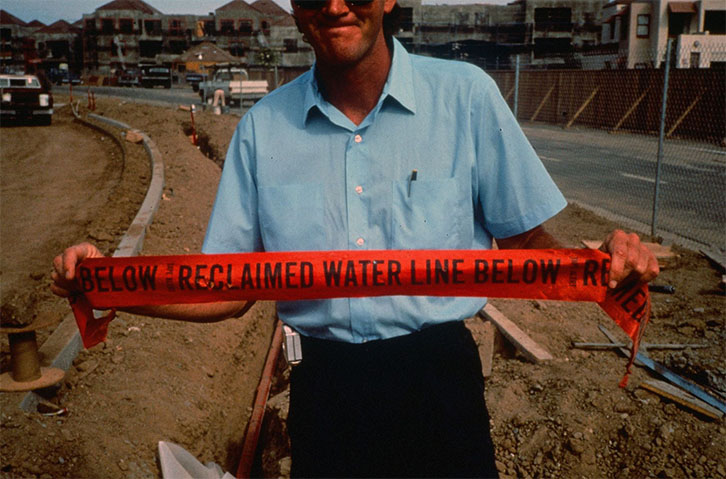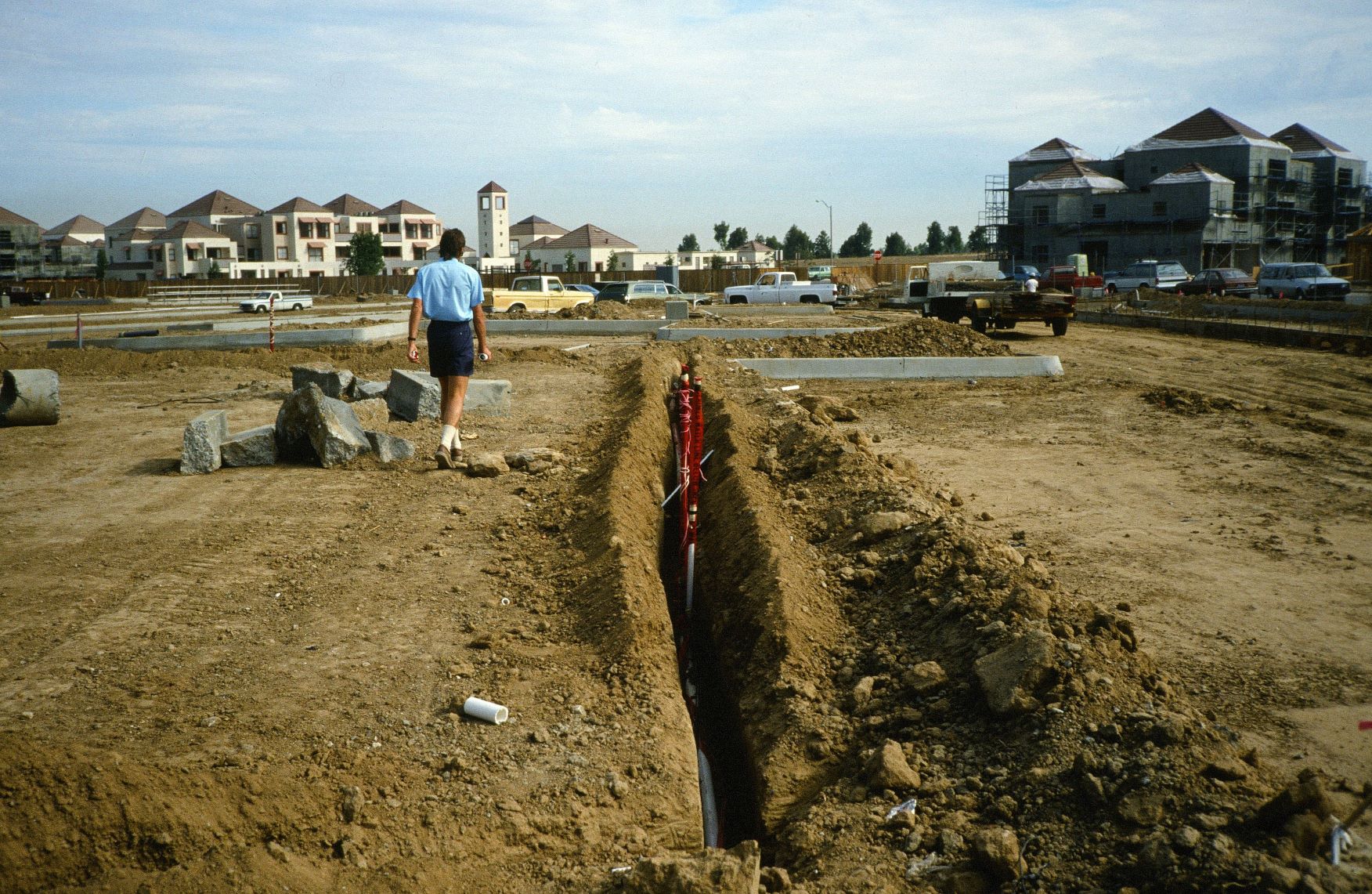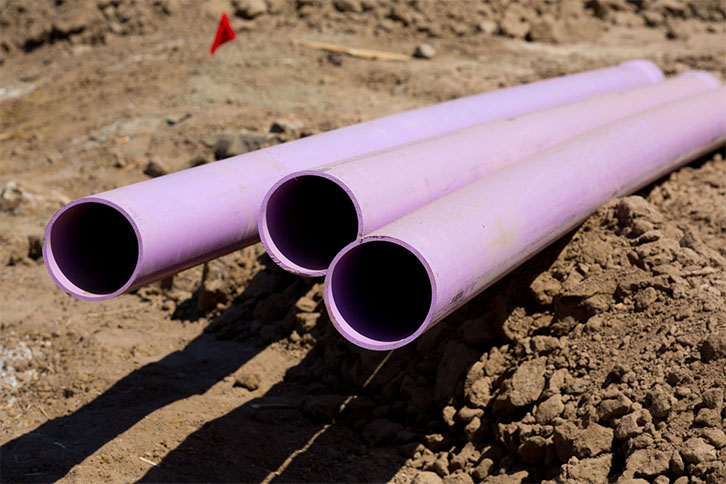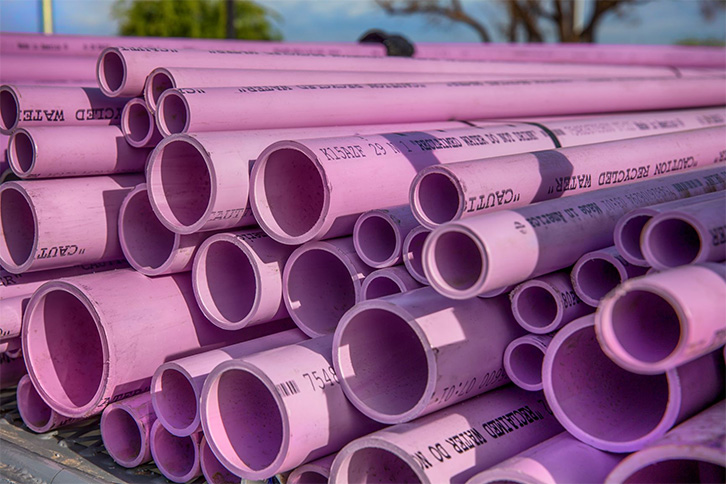-
Published: Aug 03, 2021 | 11:27 AM
Purple pipe origin story: the true tale of how IRWD set a standard for recycled water
Throughout the nation and around the world, purple pipes pulse with water that has gone down drains and been treated for reuse in landscaping, agriculture and commerce.
Irvine Ranch Water District was the mastermind behind that color: leading the charge in the early 1980s to certify a standard for pipes carrying recycled water, to distinguish them from drinking water systems.
But how did it happen? It’s a colorful story of IRWD leadership, creativity and humor — centered around an engineer who sees much of the world in neutral tones.
“Way back in the ’60s, when IRWD first started putting out recycled water to new communities, people used metal wire or tape to mark a recycled water pipeline,” explains Ron Young, a former general manager of IRWD, who in the 1980s kicked off the effort to establish a universal color standard after attending a recycled water conference in Florida.
The industry had been talking about the need to color-code those pipes — much like other utilities delivering gas, electricity and communications data have their own distinct colors — and Young put his team of bright-minded IRWD engineers to the task.
Tom Holliman, then IRWD’s senior engineer in charge of planning and recycled water systems, was active with the American Water Works Association at the time. Serendipity stepped in when he was appointed chairman of the association’s recycled water committee.
“We were asked to put our brains to it, and of course IRWD had the best engineering people in the world,” Holliman says: “Don’t ask, just do it.”
There were only so many colors left available under the Uniform Plumbing Code, because many were already taken, Holliman recalls. “There was blue for drinking water, red for firefighting, and brown — well, that sends the wrong message.”
Young says brown was already spoken for, representing combustible fluids, although St. Petersburg, Florida, was using brown at the time to identify its recycled water systems, industry documents indicate.
Eventually, IRWD picked a pinkish purple — Pantone 240 and 241 to be exact, Holliman says — and the rest is history.
Details beyond that have grown murky over time.
The colorblind engineer
Most of the credit for the color choice goes to Keith Lewinger, a longtime water professional who was IRWD’s assistant director of planning at the time.
Lewinger is among the 1 in 12 men worldwide with a red/green color vision deficiency, otherwise known as colorblindness. He sees neutral or gray tones where certain colors should appear.
“It was a running joke in the office,” Lewinger chuckles.
Young laughs, “We used to have a lot of fun with him.”
“Tom would come up to Keith and say, ‘Here’s a nice map or graphic I did,’ using the colors Keith couldn’t see, and Keith would get frustrated and say, ‘How come everything is in gray?’” adds Steve Malloy, now a retired IRWD senior engineer.
Lewinger’s inability to distinguish hues — and the prevalence of that condition — underscored the importance of picking a color that even colorblind people could see.
Lewinger remembers that Holliman came into his office one day armed with a handful of paint samples to test possible colors for the recycled water pipe.
“I pointed at the purple,” Lewinger says.
Young recalls Holliman using a fan-like Pantone formula guide for the test, spreading out shades of purple like a peacock’s tail.
Malloy, who was not directly involved, remembers Holliman going through the office one day asking people for highlighters — “pencils, crayons, whatever they could find” Malloy says. “He took those colors, went into Keith’s office and started drawing them on a piece of foam board, asking, ‘Which one can you see?’”
John Morris, a longtime leader in the water industry who worked as director of engineering and planning at IRWD from 1988 to 1994 and played a key role in getting purple pipe recognized by national and international plumbing groups, says the American Water Works Association had considered purple back when he was chair of the California Nevada Section's Dual Distribution Committee.
Similarily, Holliman says purple had already been identified as the tint to be used, based on the colors still available under the Uniform Plumbing Code. He remembers Lewinger asking him to bring in just one prototype purple pipe created as a sample for him to review.
“None of us thought too much about it at the time,” Lewinger says. “Now, here we are 40 years later, and memories are fuzzy.”
Legacy and legend
All agree that Irvine Ranch Water District selected the color that was ultimately adopted as the uniform standard.
Collaboration with local and state public health agencies, AWWA, and the Water Environment Federation helped push for the color’s official adoption nationwide and beyond.
“This is a sign of IRWD’s long-lasting leadership in the industry,” says Holliman. “It’s become a standard across the planet.”
Young agrees.
“It’s kind of neat when people outside of the industry say, ‘Oh! Purple pipe! That’s recycled water!’” Young notes. “It’s one of those things that has crept into the vernacular of everyday people.”
Holliman got a similar feeling during a trip in 2016 to tour water facilities in Israel — the world’s leading country for recycled water use.
“Even over there, the pipes are purple,” he muses. “It was really amazing to look over and see that.”
Lewinger has become a bit of a legend in the water industry, where he is sometimes asked during water works tours and events to share his story of the purple pipe — which some refer to as “Irvine Purple.”
“It hasn’t changed my life at all,” he concludes. “It’s just a fact of being in the right place at the right time, and things just worked out.”

Prior to the purple pipe, recycled water lines were identified with tape or wire.

Keith Lewinger, Ron Young and Tom Holliman (l-r) were instrumental in establishing purple pipe as the national standard for recycled water. They did this while working at IRWD.

Irvine Ranch Water District has been distributing recycled water since the 1960s, and much of the community grew up around recycled water pipeline. Shown here is an Irvine community under construction in the days before purple pipe.

Thanks to the team at IRWD, "Irvine Purple" is now used worldwide to identify recycled water pipeline.







